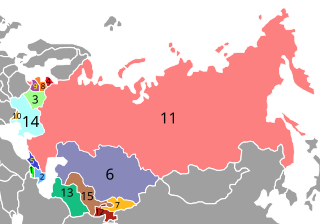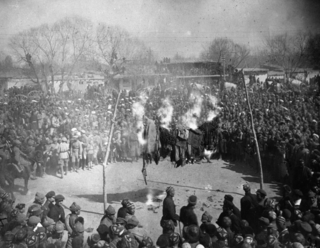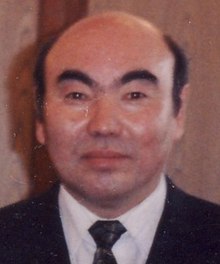
Central Asia is a region of Asia that stretches from the Caspian Sea in the west to western China and Mongolia in the east, and from Afghanistan and Iran in the south to Russia in the north. It includes the former Soviet republics of Kazakhstan, Kyrgyzstan, Tajikistan, Turkmenistan, and Uzbekistan, which are colloquially referred to as the "-stans" as the countries all have names ending with the Persian suffix "-stan", meaning "land of". Current geographical location of Central Asia was formerly part of the historic Turkistan also known as Turan.

The history of the Kyrgyz people and the land now called Kyrgyzstan goes back more than 3,000 years. Although geographically isolated by its mountainous location, it had an important role as part of the historical Silk Road trade route. Turkic nomads, who trace their ancestry to many Turkic states such as the First and Second Turkic Khaganates, have inhabited the country throughout its history. In the 13th century, Kyrgyzstan was conquered by the Mongols; subsequently it regained independence but was invaded by Kalmyks, Manchus, and Uzbeks. In 1876, it became part of the Russian Empire, remaining in the USSR as the Kirghiz Soviet Socialist Republic after the Russian Revolution. Following Mikhael Gorbachev's democratic reforms in the USSR, in 1990 pro-independence candidate Askar Akayev was elected president of the SSR. On 31 August 1991, Kyrgyzstan declared independence from Moscow, and a democratic government was subsequently established.

The Soviet Union, officially the Union of Soviet Socialist Republics (USSR), was a transcontinental country that spanned much of Eurasia from 1922 to 1991. A flagship communist state, it was nominally a federal union of fifteen national republics; in practice, both its government and its economy were highly centralized until its final years. It was a one-party state governed by the Communist Party of the Soviet Union, with the city of Moscow serving as its capital as well as that of its largest and most populous republic: the Russian SFSR. Other major cities included Leningrad, Kiev, Minsk, Tashkent, Alma-Ata, and Novosibirsk. It was the largest country in the world, covering over 22,402,200 square kilometres (8,649,500 sq mi) and spanning eleven time zones.

Tajikistan, officially the Republic of Tajikistan, is a landlocked country in Central Asia. It has an area of 143,100 km2 (55,300 sq mi) and an estimated population of 9,749,625 people. Its capital and largest city is Dushanbe. It is bordered by Afghanistan to the south, Uzbekistan to the west, Kyrgyzstan to the north, and China to the east. It is separated narrowly from Pakistan by Afghanistan's Wakhan Corridor. The traditional homelands of the Tajiks include present-day Tajikistan as well as parts of Afghanistan and Uzbekistan.

Uzbekistan is a landlocked country in Central Asia. It is itself surrounded by five landlocked countries: Kazakhstan to the north; Kyrgyzstan to the northeast; Tajikistan to the southeast; Afghanistan to the south, Turkmenistan to the south-west. Its capital and largest city is Tashkent. Uzbekistan is part of the Turkic languages world, as well as a member of the Organization of Turkic States. While the Uzbek language is the majority spoken language in Uzbekistan, Russian is widely used as an inter-ethnic tongue and in government. Islam is the majority religion in Uzbekistan, most Uzbeks being non-denominational Muslims. In ancient times it largely overlapped with the region known as Sogdia, and also with Bactria.
According to data from the 1989 Soviet census, the population of the USSR was 70% East Slavs, 17% Turkic peoples, and all other ethnic groups below 2%. Alongside the atheist majority of 60% there were sizable minorities of Russian Orthodox Christians and Muslims.

Kyrgyzstan, or the Kyrgyz Republic, is a landlocked country in Central Asia. Kyrgyzstan is bordered by Kazakhstan to the north, Uzbekistan to the west, Tajikistan to the south, and the People's Republic of China to the east. Its capital and largest city is Bishkek.

The Turkmen Soviet Socialist Republic, also commonly known as Turkmenistan or Turkmenia, was one of the constituent republics of the Soviet Union located in Central Asia existed as a republic from 1925 to 1991. Initially, on 7 August 1921, it was established as the Turkmen Oblast of the Turkestan ASSR before being made, on 13 May 1925, a separate republic of the USSR as the Turkmen SSR.

A communist state, also known as a Marxist–Leninist state, is a one-party state that is administered and governed by a communist party guided by Marxism–Leninism. Marxism–Leninism was the state ideology of the Soviet Union, the Comintern after Bolshevisation and the communist states within the Comecon, the Eastern Bloc and the Warsaw Pact. Marxism–Leninism currently still remains the ideology of a few parties around the world. After its peak when many communist states were established, the Revolutions of 1989 brought down most of the communist states, however, it is still the official ideology of the ruling parties of China, Cuba, Laos, and Vietnam. During most of the 20th century, before the Revolutions of 1989, around one-third of the world's population lived under communist states.

Russian Turkestan was the western part of Turkestan within the Russian Empire’s Central Asian territories, and was administered as a Krai or Governor-Generalship. It comprised the oasis region to the south of the Kazakh Steppe, but not the protectorates of the Emirate of Bukhara and the Khanate of Khiva.
A transition economy or transitional economy is an economy which is changing from a centrally planned economy to a market economy. Transition economies undergo a set of structural transformations intended to develop market-based institutions. These include economic liberalization, where prices are set by market forces rather than by a central planning organization. In addition to this trade barriers are removed, there is a push to privatize state-owned enterprises and resources, state and collectively run enterprises are restructured as businesses, and a financial sector is created to facilitate macroeconomic stabilization and the movement of private capital. The process has been applied in China, the former Soviet Union and Eastern bloc countries of Europe and some Third world countries, and detailed work has been undertaken on its economic and social effects.

The post-Soviet states, also known as the former Soviet Union (FSU), the former Soviet Republics and in Russia as the near abroad, are the 15 sovereign states that were union republics of the Soviet Union, which emerged and re-emerged from the Soviet Union following its dissolution in 1991.

National delimitation in the Union of Soviet Socialist Republics was the process of specifying well-defined national territorial units from the ethnic diversity of the Union of Soviet Socialist Republics (USSR) and its subregions. The Russian-language term for this Soviet state policy was razmezhevanie, which is variously translated in English-language literature as "national-territorial delimitation" (NTD), "demarcation", or "partition". National delimitation formed part of a broader process of changes in administrative-territorial division, which also changed the boundaries of territorial units, but was not necessarily linked to national or ethnic considerations. National delimitation in the USSR was distinct from nation-building, which typically referred to the policies and actions implemented by the government of a national territorial unit after delimitation. In most cases national delimitation in the USSR was followed by korenizatsiya (indigenization).

Hujum was a series of policies and actions taken by the Communist Party of the Soviet Union, initiated by Joseph Stalin, to remove all manifestations of gender inequality, especially on the systems of female veiling and seclusion practiced in Central Asia. The era was often symbolized by the burning of the face-veil that women in the Muslim majority areas of the Soviet Union wore, but removal of the veil was not the sole goal of the campaign. The party began re-emphasizing their messages women's liberation within class consciousness. By abolishing them in Central Asia and heralding in women's liberation, the Soviets believed they could clear the way for the construction of socialism. The campaign's purpose was to rapidly change the lives of women in Muslim societies so that they may participate in public life, paid work, education, and ultimately membership in the Communist Party. It was originally conceived to enforce laws that gave women in patriarchal societies equality by creating literacy programs and bringing women into the labor force.

Soviet Central Asia was the part of Central Asia administered by the Soviet Union between 1918 and 1991, when the Central Asian republics declared independence. It is nearly synonymous with Russian Turkestan in the Russian Empire. Soviet Central Asia went through many territorial divisions before the current borders were created in the 1920s and 1930s.

The Union of Soviet Socialist Republics (USSR) was a federation made up of 15 Soviet socialist republics, and existed from 1922 until its dissolution in 1991. Six of the 15 republics had a Muslim majority: Azerbaijan, Kazakhstan, Kirghizia (Kyrgyzstan), Tajikistan, Turkmenistan, and Uzbekistan. There was also a large Muslim population in the Volga-Ural region and in the northern Caucasus region of the Russian Soviet Federative Socialist Republic. Many Tatar Muslims also lived in Siberia and other regions.

Islam in Central Asia has existed since the beginning of Islamic history. Sunni branch of Islam is the most widely practiced religion in Central Asia. Shiism of Imami and Ismaili denominations predominating in the Pamir plateau and the western Tian Shan mountains, while boasting to a large minority population in the Zarafshan river valley, from Samarkand to Bukhara. Islam came to Central Asia in the early part of the 8th century as part of the Muslim conquest of the region. Many well-known Islamic scientists and philosophers came from Central Asia, and several major Muslim empires, including the Timurid Empire and the Mughal Empire, originated in Central Asia. In the 20th century, severe restrictions on religious practice were enacted by the Soviet Union in Soviet Central Asia and the People's Republic of China in Xinjiang.

The Kirghiz Soviet Socialist Republic or Kyrgyz Soviet Socialist Republic, or Kirgiz Soviet Socialist Republic, also commonly known as the Kyrgyzstan and Soviet Kyrgyzstan in the Kyrgyz language and as Kirghizia and Soviet Kirghizia in the Russian language, was one of the constituent republics of the Soviet Union (USSR) from 1936 to 1991.
The Eleventh Five-Year Plan, or the 11th Five-Year Plan, of the Union of Soviet Socialist Republics (USSR) was a set of goals designed to strengthen the country's economy between 1981 and 1985. The plan was presented by the Chairman of the Council of Ministers Nikolai Tikhonov at the 26th Congress of the Communist Party of the Soviet Union (CPSU).
Armenians in Central Asian states: Uzbekistan, Kazakhstan, Kyrgyzstan, Tajikistan and Turkmenistan, were mainly settled there during the Soviet era for various reasons.
















